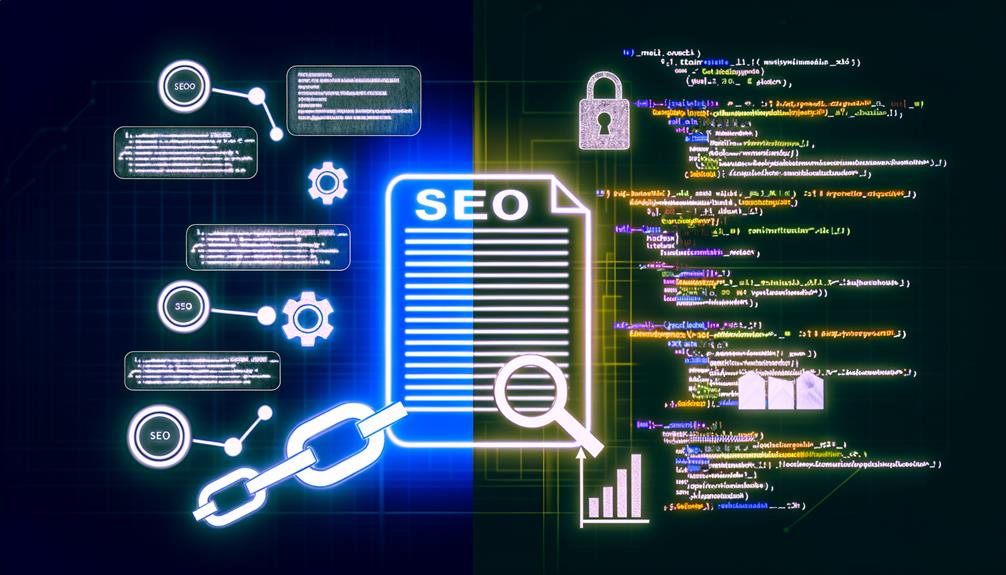Yes, there's a significant difference between standard SEO and programmatic SEO. Standard SEO relies on meticulous keyword research, on-page enhancements, and strategic link building. It's a manual, hands-on approach that demands continuous monitoring and adjustments. On the other hand, programmatic SEO automates content creation and optimization using data-driven techniques. This method leverages real-time data and automation for scalability and efficiency, enabling us to generate bulk content rapidly while adapting to search engine algorithms. By understanding these distinctions, we can determine which approach best suits our digital marketing goals and resources, leading to enhanced SEO performance and competitiveness.
Key Takeaways
- Standard SEO relies on manual content creation and optimization, while Programmatic SEO uses automation for scalability and efficiency.
- Programmatic SEO leverages data-driven strategies, automating keyword research and content generation to quickly adapt to changes.
- Standard SEO focuses on creating high-quality, personalized content tailored to the audience's needs.
- Programmatic SEO can produce thousands of optimized pages swiftly using templates and databases.
- Manual optimization in Standard SEO ensures meticulous customization, while Programmatic SEO streamlines repetitive tasks for time-saving and effective strategies.
Overview of Standard SEO
Standard SEO, a foundational pillar for digital marketing, involves optimizing individual web pages through meticulous keyword research, on-page enhancements, technical fine-tuning, and strategic link building to boost organic search engine rankings.
When we delve into standard SEO, we're focusing on driving targeted organic traffic and improving our website's visibility. It all starts with keyword research, where we identify the terms our audience uses to find relevant content. By targeting these keywords, we guarantee our pages align with user intent.
Next, we address on-page optimization. This includes refining meta tags, headers, and content to make our pages more attractive to search engines. Quality content is paramount; it must be engaging, informative, and valuable to our readers.
Technical SEO is equally important, addressing aspects like site speed, mobile-friendliness, and secure connections to enhance user experience and crawlability.
Link building serves as the backbone of our strategy. High-quality backlinks from authoritative sites signal to search engines that our content is credible and trustworthy.
Together, these elements form a cohesive approach that requires ongoing monitoring and adjustments to stay competitive. By consistently refining our SEO efforts, we maintain and grow our organic traffic, ensuring our website's long-term success.
Overview of Programmatic SEO

In programmatic SEO, we focus on automated content creation, leveraging data-driven strategies to enhance our keyword targeting.
This method allows us to scale efficiently by setting up database-page template connections that generate bulk pages.
Automated Content Creation
Leveraging automation, programmatic SEO enables us to generate high-quality, data-driven content at scale by creating bulk pages based on meticulously designed templates and robust databases. Automated content creation is at the heart of this process.
We start with thorough keyword research to identify valuable search terms and topics that align with our target audience's interests. This research informs our dataset preparation, making sure we gather and organize relevant data that supports our content strategy.
Designing effective page templates is essential. These templates serve as blueprints for the content, allowing us to maintain consistency and SEO best practices across thousands of pages. By setting up strong database-page template connections, we make certain that each page is populated with unique, high-quality content tailored to specific keywords and user intent.
Our approach transforms the way we handle content creation, moving from manual to automated processes that save time and resources. By focusing on data-driven strategies and leveraging the power of automation, we can deliver content that not only meets SEO standards but also engages and resonates with our audience.
Together, we can achieve scalable, high-quality content production that drives traffic and growth.
Data-Driven Strategies
Harnessing the power of data-driven strategies, programmatic SEO automates the optimization of SEO tasks at scale, enabling us to identify trends, capitalize on opportunities, and continuously improve our performance. By leveraging a data-driven approach, we can utilize automated tools to streamline keyword research, content creation, and performance monitoring. This not only saves time but also guarantees that our SEO strategy is informed by real-time data, allowing us to make quick adjustments based on user behavior.
In programmatic SEO, data analysis plays an essential role in identifying trends and pinpointing areas for improvement. By continuously analyzing performance metrics, we can uncover valuable insights that contribute to improving the quality of our SEO efforts. Automated tools help us process vast amounts of data efficiently, providing us with actionable insights that drive our SEO strategy forward.
Real-time data allows us to respond swiftly to changes in user behavior and search engine algorithms, ensuring that our content remains relevant and competitive. This dynamic approach not only boosts organic traffic but also enhances our search rankings over time. By embracing a data-driven approach, we can guarantee that our SEO efforts are both effective and sustainable, fostering a sense of belonging within our digital community.
Scalability and Efficiency
By automating keyword research and content creation, programmatic SEO guarantees we achieve scalability and efficiency in our SEO efforts. This automation enables us to generate high-quality content at scale, effectively targeting a diverse range of keywords. The scalability provided by programmatic SEO is unparalleled, allowing us to adapt in real-time to shifting search engine algorithms and user behavior.
Through the power of automation, we can process vast amounts of data quickly, ensuring our SEO strategies are always data-driven and precise. This efficiency not only optimizes our resources but also maximizes our overall SEO performance. By leveraging these automated processes, we can focus on strategic planning and innovative approaches, rather than getting bogged down in repetitive tasks.
Programmatic SEO provides a significant competitive edge. It harnesses the precision of data analysis and the capabilities of scalable content generation, setting us apart in the crowded digital landscape. Our ability to adapt swiftly and efficiently to market changes ensures we remain at the forefront of SEO advancements.
In essence, programmatic SEO transforms our approach, making our efforts more effective and resource-efficient, ultimately driving better results for our business.
Key Differences Explained

Let's break down key differences in approach to content creation, scale, and automation between standard SEO and programmatic SEO.
While standard SEO relies on manual optimization techniques, programmatic SEO leverages automation to generate bulk pages using data-driven strategies.
This distinction highlights the importance of understanding SEO fundamentals to effectively implement programmatic methods and achieve scalable results.
Approach to Content Creation
In the field of content creation, the key differences between standard SEO and programmatic SEO lie in the methodologies employed to optimize for search engine rankings. Standard SEO emphasizes manual content creation tailored to specific audience needs and search intent, aiming for quality and relevance. We meticulously conduct in-depth keyword research to craft personalized content that resonates with our target audience. This approach guarantees that each piece of content is highly relevant and valuable, enhancing organic search rankings.
On the other hand, programmatic SEO leverages automation to streamline content creation processes, offering significant scalability and efficiency. By using data-driven techniques, we can generate bulk pages based on predefined templates and datasets. This mass production strategy allows us to quickly populate a website with a large volume of content, ensuring that we cover a broad spectrum of search queries.
While standard SEO prioritizes the quality of individual pieces, programmatic SEO focuses on creating a high volume of content efficiently.
Both approaches have their place in a thorough SEO strategy, and understanding when to apply each can greatly impact our search engine performance. By balancing manual, high-quality content with automated, scalable solutions, we can achieve excellent results.
Scale and Automation
Moving from content creation methodologies, we now examine how scale and automation set standard SEO and programmatic SEO apart.
Standard SEO involves manual optimization and customization for individual pages, making it labor-intensive and less scalable. In contrast, programmatic SEO leverages automation to streamline the process, enabling bulk page creation using templates and databases.
Programmatic SEO's scalability is unparalleled. By automating the generation of content, we can swiftly produce thousands of pages, each optimized for specific keywords and search intents. This approach greatly enhances efficiency, allowing us to focus on strategic oversight rather than repetitive tasks.
Automation: Programmatic SEO automates repetitive tasks, such as keyword insertion and meta tag creation, freeing up time for more strategic activities.
Scalability: With the ability to create and optimize thousands of pages quickly, programmatic SEO far outpaces standard SEO when it comes to scale.
Bulk Page Creation: Utilizing templates and databases, programmatic SEO enables the efficient generation of large volumes of content.
These advantages are rooted in data-driven strategies that programmatic SEO employs, ensuring that each page meets specific search criteria. By adopting programmatic SEO, we harness the power of automation and scalability, driving efficiency and enhancing our SEO efforts.
Data-Driven Strategies
Data-driven strategies fundamentally distinguish programmatic SEO from standard SEO, leveraging automation and AI to optimize content generation with unparalleled efficiency and precision. In programmatic SEO, we use thorough data analysis to identify untapped SEO opportunities that manual methods might miss. By automating bulk page creation based on templates and databases, we achieve scalability that standard SEO can't match.
Programmatic SEO's reliance on AI-powered algorithms means we can generate high-quality content tailored to specific data insights. This automation not only enhances precision but also greatly boosts our efficiency. Unlike standard SEO, which often involves time-consuming manual data analysis and strategy implementation, programmatic SEO allows us to scale our operations seamlessly.
Here's a clear comparison of key differences:
| Aspect | Standard SEO | Programmatic SEO |
|---|---|---|
| Data Analysis | Manual | Automated |
| Content Generation | Manual | AI-Powered |
| Scalability | Limited | High |
| Efficiency | Moderate | High |
| Precision | Variable | High |
Manual Strategies in SEO

Manual SEO strategies demand hands-on optimization to guarantee each web page is meticulously tailored for search engine success. By focusing on manual strategies, we guarantee individual web pages receive the attention they deserve, allowing us to finely tune each element for peak performance.
Our efforts start with thorough keyword research to identify the most relevant and high-traffic search terms. This foundational step informs our content creation, ensuring it aligns with user intent and search engine algorithms.
Next, link building plays an important role in bolstering our site's authority. By securing high-quality backlinks, we enhance our web pages' credibility and search engine rankings.
The beauty of manual strategies lies in their customization. We can address specific SEO challenges unique to our business, tailoring our approach to meet those needs precisely.
Key components of our manual SEO strategy include:
- Keyword research: Identifying and integrating high-value keywords to drive traffic.
- Content creation: Crafting engaging, relevant, and optimized content for our audience.
- Link building: Establishing authoritative backlinks to improve domain authority.
While manual SEO can be time-consuming, the level of control and customization it offers makes it indispensable for achieving targeted, data-driven results.
Automation in Programmatic SEO

Leveraging automation tools, programmatic SEO allows us to efficiently manage keyword research, content generation, and performance monitoring at scale. By automating these critical processes, we can seamlessly handle large volumes of data and tasks that would be impractical with manual efforts. This approach not only enhances our ability to scale but also uncovers untapped opportunities that might otherwise go unnoticed.
Automation enables us to perform A/B testing on various elements of our web pages, giving us data-driven insights to optimize user experience and search rankings. We can test different headlines, meta descriptions, and content formats to determine which combinations yield the best results. This iterative process, powered by automation, ensures our strategies are continually refined and improved.
Moreover, automated indexing and content updates guarantee that our website remains aligned with the latest search engine algorithms. This proactive approach allows us to make timely adjustments, keeping our content relevant and competitive. By leveraging these automated processes, we're not just saving time; we're also driving more effective and scalable SEO strategies.
Data-Driven Techniques

Harnessing real-time analytics, we can refine our SEO strategies with pinpoint accuracy and drive impactful results. Through data-driven techniques, we leverage automation to streamline processes such as keyword research and content generation. By continuously analyzing data, we identify opportunities for optimization, guaranteeing our strategies are both dynamic and effective.
Programmatic SEO thrives on real-time data insights, enabling us to make informed decisions swiftly. This allows for dynamic adaptation, whether we're adjusting keyword usage or content strategies based on performance metrics. The precision in data analysis ensures we're always a step ahead, optimizing our approach for maximum impact.
Key benefits of using data-driven techniques in programmatic SEO include:
- Continuous Monitoring: Automation tools provide constant oversight, allowing us to track performance metrics and make real-time adjustments.
- A/B Testing: By testing different strategies, we can determine the most effective methods, optimizing SEO performance based on data feedback.
- Scalability: Data-driven precision enables us to efficiently scale our SEO efforts, achieving greater results with less manual intervention.
Through these techniques, we're not just reacting to changes in the digital landscape; we're proactively shaping our SEO strategies to stay ahead. This alignment with real-time data insights guarantees we're consistently optimizing for success.
Pros and Cons of Each

As we evaluate the strengths and weaknesses of both standard and programmatic SEO, it's clear that each approach offers unique advantages depending on our specific needs and resources.
Programmatic SEO excels in automation and scalability, making it an efficient choice for generating and optimizing large volumes of content quickly. This approach allows us to leverage data-driven techniques to identify and capitalize on SEO opportunities at scale, which is particularly beneficial for extensive websites or e-commerce platforms.
On the other hand, traditional SEO provides more control and precision in content creation and optimization. This SEO approach is ideal for those of us who prioritize high-quality content marketing and want to make certain that every piece of content is meticulously crafted and optimized. While traditional SEO may require more time and manual effort, the personalized touch often results in higher-quality content that better resonates with our audience.
The difference between programmatic and traditional SEO approaches lies in the balance between efficiency and quality. Programmatic SEO can quickly adapt to changing search engine algorithms, whereas traditional SEO allows for deeper, more targeted content strategies.
Ultimately, our choice depends on our specific goals, whether we prioritize rapid scalability or nuanced, high-quality content.
Case Studies

Frequently, real-world examples illustrate the tangible benefits of programmatic SEO, as evidenced by our case studies on e-commerce and healthcare sectors.
In one case, a US e-commerce retailer saw a significant organic traffic increase by optimizing specific product categories with a programmatic SEO strategy. Leveraging CMAX technology, they achieved unique content generation that aligned perfectly with search engine algorithms, catering to evolving market needs.
Similarly, a leading healthcare provider in Australia experienced a 21.4% organic traffic increase. This success was attributed to the implementation of programmatic SEO, which enabled them to dynamically adapt to market needs and search engine algorithms. These case studies highlight the practical applications and benefits of programmatic SEO.
- E-commerce Retailer: Increased organic traffic by optimizing product categories.
- CMAX Technology: Facilitated unique content generation.
- Healthcare Provider: Achieved a 21.4% organic traffic increase through dynamic adaptation.
Choosing the Right Approach

Choosing the right SEO approach hinges on understanding your business goals, available resources, and the desired level of automation in your strategy.
When evaluating Programmatic SEO versus traditional SEO, we need to take into account several key factors that align with our objectives.
Programmatic SEO offers notable advantages in relation to scalability and efficiency. Through automation, tasks like keyword research and content creation become streamlined, allowing us to target long-tail keywords with precision. This data-driven approach to SEO can be a game-changer for businesses looking to generate content at scale without compromising on optimization quality.
On the other hand, traditional SEO focuses heavily on manual optimization efforts. Quality content creation, backlink building, and meticulous keyword planning are at the forefront of this approach. While it requires more time and resources, traditional SEO excels in delivering high-quality, authoritative content that can significantly enhance organic rankings.
The difference between traditional and Programmatic SEO ultimately comes down to our specific needs and capabilities. If our SEO efforts require rapid scaling and data-driven insights, Programmatic SEO might be the ideal choice. However, if we prioritize quality over quantity and have the resources for manual implementation, traditional SEO could be more effective.
Frequently Asked Questions
What Is the Difference Between Traditional SEO and Programmatic Seo?
The distinction is in approach: traditional SEO relies on manual keyword research, backlink strategies, and meta tags, while programmatic SEO automates content creation using search algorithms, enhancing scalability and efficiency. Both require a solid SEO foundation.
What Does Programmatic SEO Mean?
Programmatic SEO means revolutionizing our strategy with automation tools, data analysis, and content generation. We harness algorithm updates and keyword clustering to scale SEO efforts like never before. Together, we transform traditional practices into a data-driven powerhouse.
What Is the Difference Between Programmatic SEO and Semantic Seo?
We differentiate programmatic SEO and semantic SEO by their focus: programmatic SEO uses content automation and data structuring to scale, while semantic SEO prioritizes understanding keyword intent and leveraging semantic networks to align with search algorithms.
What Is the Difference Between Programmatic and Editorial Seo?
We see programmatic SEO leveraging keyword clustering, content automation, and SEO tools for scale, while editorial SEO focuses on high-quality content, strict editorial guidelines, and a robust backlink strategy. Combining both can maximize our SEO impact.
Conclusion
In the ever-evolving SEO landscape, we've seen that standard SEO is like a craftsman's detailed handiwork, while programmatic SEO operates at lightning speed, leveraging data and automation.
Each approach has its strengths and pitfalls. By understanding these differences, we can tailor our strategies to specific goals, blending manual precision with automated efficiency.
Ultimately, choosing the right SEO method can be the key to unleashing unparalleled digital growth. Let's harness the power of both for best results.
